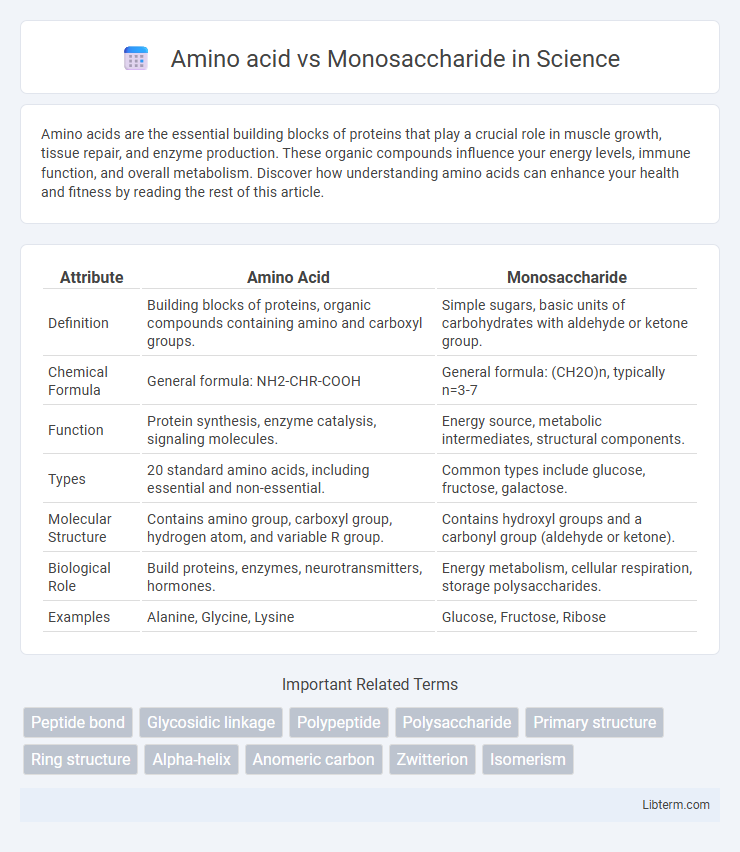Amino acids are the essential building blocks of proteins that play a crucial role in muscle growth, tissue repair, and enzyme production. These organic compounds influence your energy levels, immune function, and overall metabolism. Discover how understanding amino acids can enhance your health and fitness by reading the rest of this article.
Table of Comparison
| Attribute | Amino Acid | Monosaccharide |
|---|---|---|
| Definition | Building blocks of proteins, organic compounds containing amino and carboxyl groups. | Simple sugars, basic units of carbohydrates with aldehyde or ketone group. |
| Chemical Formula | General formula: NH2-CHR-COOH | General formula: (CH2O)n, typically n=3-7 |
| Function | Protein synthesis, enzyme catalysis, signaling molecules. | Energy source, metabolic intermediates, structural components. |
| Types | 20 standard amino acids, including essential and non-essential. | Common types include glucose, fructose, galactose. |
| Molecular Structure | Contains amino group, carboxyl group, hydrogen atom, and variable R group. | Contains hydroxyl groups and a carbonyl group (aldehyde or ketone). |
| Biological Role | Build proteins, enzymes, neurotransmitters, hormones. | Energy metabolism, cellular respiration, storage polysaccharides. |
| Examples | Alanine, Glycine, Lysine | Glucose, Fructose, Ribose |
Introduction to Amino Acids and Monosaccharides
Amino acids are organic compounds composed of an amino group, carboxyl group, and a unique side chain, serving as the building blocks of proteins essential for cellular function and metabolism. Monosaccharides, the simplest form of carbohydrates, consist of a single sugar molecule with a backbone of three to seven carbon atoms, fundamental for energy production and metabolic pathways. Both amino acids and monosaccharides play critical roles in biological systems, with amino acids participating primarily in protein synthesis while monosaccharides are key energy sources.
Chemical Structure Comparison
Amino acids consist of a central carbon atom bonded to an amino group (-NH2), a carboxyl group (-COOH), a hydrogen atom, and a variable side chain (R group), which defines their properties. Monosaccharides have a carbon backbone with multiple hydroxyl groups (-OH) and either an aldehyde or ketone functional group, forming ring or linear structures primarily composed of carbon, hydrogen, and oxygen in a typical 1:2:1 ratio. The presence of nitrogen in amino acids contrasts with the solely carbon, hydrogen, and oxygen composition in monosaccharides, highlighting a fundamental chemical distinction.
Biological Functions and Roles
Amino acids serve as the fundamental building blocks of proteins, playing critical roles in enzyme catalysis, neurotransmitter transport, and cellular signaling pathways. Monosaccharides, such as glucose and fructose, are primary energy sources that participate in metabolic processes like glycolysis and cellular respiration. Both molecules are essential for cell structure and function, with amino acids contributing to protein synthesis and monosaccharides providing immediate energy and carbon skeletons for biosynthetic pathways.
Dietary Sources
Amino acids are primarily obtained from dietary proteins found in meat, fish, dairy, eggs, legumes, and nuts, providing essential building blocks for muscle synthesis and enzyme production. Monosaccharides, such as glucose and fructose, are derived from natural sources like fruits, honey, and vegetables, serving as immediate energy substrates. Both nutrients are crucial for maintaining metabolic functions but differ significantly in their dietary origins and biochemical roles.
Metabolism Pathways
Amino acids undergo catabolic pathways such as transamination and deamination to enter the citric acid cycle and support gluconeogenesis, while monosaccharides primarily enter glycolysis after phosphorylation to produce energy. Amino acid metabolism involves nitrogen removal and integration into urea cycle, contrasting with monosaccharide metabolism that centers on carbohydrate breakdown and storage as glycogen. These distinct pathways highlight amino acids' role in protein turnover and energy production, whereas monosaccharides serve as the primary substrates for ATP generation through glycolysis and oxidative phosphorylation.
Importance in Human Health
Amino acids, as the building blocks of proteins, are essential for muscle repair, enzyme production, and neurotransmitter synthesis, playing a critical role in overall human health. Monosaccharides, such as glucose, serve as the primary energy source for cellular functions, fueling brain activity and metabolic processes. Both compounds are vital; amino acids support structural and functional maintenance, while monosaccharides provide immediate energy necessary for physiological homeostasis.
Industrial and Medical Applications
Amino acids serve as essential building blocks in pharmaceutical manufacturing for producing peptides and vaccines, while monosaccharides are crucial in the synthesis of biocompatible hydrogels and drug delivery systems. Industrially, amino acids are widely employed in fermentation processes to enhance microbial production of antibiotics and enzymes, whereas monosaccharides are pivotal in biofuel development and as chiral intermediates in chemical synthesis. Medical applications leverage amino acids in parenteral nutrition to support patient recovery, while monosaccharides play critical roles in diagnostic assays and glycoprotein-based therapeutics.
Key Differences in Physical Properties
Amino acids typically have higher melting points than monosaccharides due to their zwitterionic nature, which leads to strong intermolecular ionic bonds. Monosaccharides are highly soluble in water because of multiple hydroxyl groups enabling extensive hydrogen bonding. Unlike monosaccharides, amino acids exhibit amphoteric behavior, acting as both acids and bases, which influences their solubility and crystallization properties.
Interactions with Other Biomolecules
Amino acids interact extensively with nucleotides and lipids through hydrogen bonding and ionic interactions, facilitating protein synthesis and membrane formation. Monosaccharides primarily engage in glycosidic bonds with other sugars and form covalent linkages with proteins and lipids, creating glycoproteins and glycolipids essential for cell recognition and signaling. Both biomolecules play critical roles in constructing complex structures and mediating cellular communication.
Summary: Amino Acid vs Monosaccharide
Amino acids are organic compounds that serve as the building blocks of proteins, containing an amino group, a carboxyl group, and a variable side chain, whereas monosaccharides are the simplest form of carbohydrates composed of single sugar molecules like glucose or fructose. Amino acids play a crucial role in enzymatic functions, muscle repair, and neurotransmitter synthesis, while monosaccharides primarily provide energy through cellular respiration and form the basis for complex carbohydrates such as disaccharides and polysaccharides. The key biochemical distinction lies in their molecular structure and function: amino acids contribute to protein synthesis and metabolic pathways, whereas monosaccharides are central to energy metabolism and structural carbohydrates.
Amino acid Infographic

 libterm.com
libterm.com